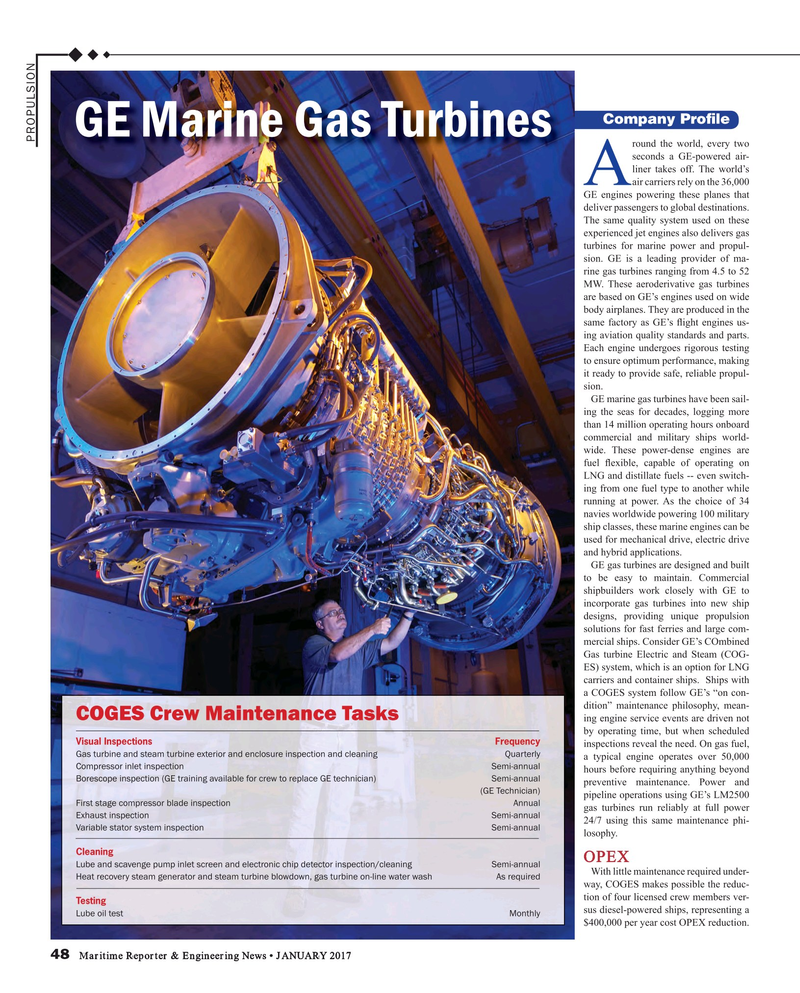
Page 48: of Maritime Reporter Magazine (January 2017)
The Ship Repair & Conversion Edition
Read this page in Pdf, Flash or Html5 edition of January 2017 Maritime Reporter Magazine
Company Pro? le
GE Marine Gas Turbines
PROPULSION round the world, every two seconds a GE-powered air- liner takes off. The world’s
Aair carriers rely on the 36,000
GE engines powering these planes that deliver passengers to global destinations.
The same quality system used on these experienced jet engines also delivers gas turbines for marine power and propul- sion. GE is a leading provider of ma- rine gas turbines ranging from 4.5 to 52
MW. These aeroderivative gas turbines are based on GE’s engines used on wide body airplanes. They are produced in the same factory as GE’s ? ight engines us- ing aviation quality standards and parts.
Each engine undergoes rigorous testing to ensure optimum performance, making it ready to provide safe, reliable propul- sion.
GE marine gas turbines have been sail- ing the seas for decades, logging more than 14 million operating hours onboard commercial and military ships world- wide. These power-dense engines are fuel ? exible, capable of operating on
LNG and distillate fuels -- even switch- ing from one fuel type to another while running at power. As the choice of 34 navies worldwide powering 100 military ship classes, these marine engines can be used for mechanical drive, electric drive and hybrid applications.
GE gas turbines are designed and built to be easy to maintain. Commercial shipbuilders work closely with GE to incorporate gas turbines into new ship designs, providing unique propulsion solutions for fast ferries and large com- mercial ships. Consider GE’s COmbined
Gas turbine Electric and Steam (COG-
ES) system, which is an option for LNG carriers and container ships. Ships with a COGES system follow GE’s “on con- dition” maintenance philosophy, mean-
COGES Crew Maintenance Tasks ing engine service events are driven not by operating time, but when scheduled
Visual Inspections Frequency inspections reveal the need. On gas fuel,
Gas turbine and steam turbine exterior and enclosure inspection and cleaning Quarterly a typical engine operates over 50,000
Compressor inlet inspection Semi-annual hours before requiring anything beyond
Borescope inspection (GE training available for crew to replace GE technician) Semi-annual preventive maintenance. Power and (GE Technician) pipeline operations using GE’s LM2500
First stage compressor blade inspection Annual gas turbines run reliably at full power
Exhaust inspection Semi-annual 24/7 using this same maintenance phi-
Variable stator system inspection Semi-annual losophy.
Cleaning
OPEX
Lube and scavenge pump inlet screen and electronic chip detector inspection/cleaning Semi-annual
With little maintenance required under-
Heat recovery steam generator and steam turbine blowdown, gas turbine on-line water wash As required way, COGES makes possible the reduc- tion of four licensed crew members ver-
Testing sus diesel-powered ships, representing a
Lube oil test Monthly $400,000 per year cost OPEX reduction. 48 Maritime Reporter & Engineering News • JANUARY 2017
MR #1 (42-49).indd 48 MR #1 (42-49).indd 48 1/10/2017 11:48:00 AM1/10/2017 11:48:00 AM

 47
47

 49
49
